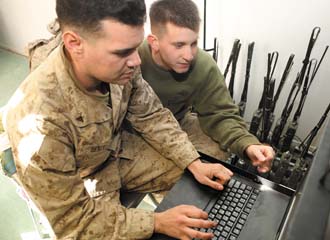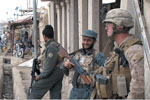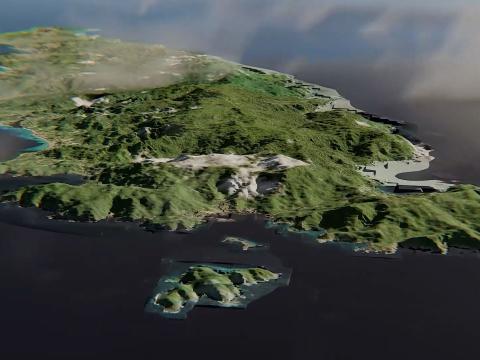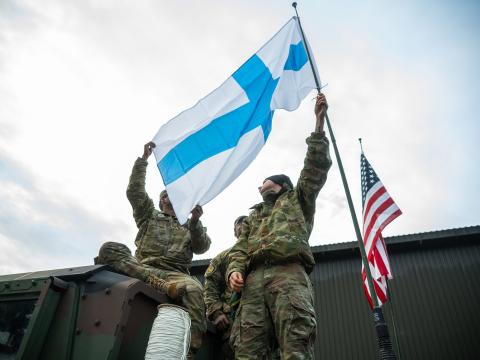Marines Revolutionize Network In Southwest Afghanistan
[Editor’s Note: This is the first of two articles based on interviews with U.S. Marines while they were deployed in Afghanistan. The second piece will run in the June edition of SIGNAL.]
 |
Lance Cpl. Shawn Braly, USMC (l), and Cpl. Brandon McCreight, USMC, mobile multichannel operators, input data into the Virtual Terminal 100 at Camp Leatherneck, Afghanistan. The young Marines deployed with Radio Platoon, Alpha Company, 9th Communications Battalion, 1st Marine Expeditionary Force (I MEF) (Forward) to the dangerous Helmand Province. |
Members of the 1st Marine Expeditionary Force (Forward) recently spent a year in what is arguably the most dangerous place on the planet for a U.S. service member—Helmand Province, Afghanistan. During the deployment, combat communicators were tasked with the normal duties of equipment operations and data transmission security. But by the time they came home, they had celebrated other noteworthy accomplishments, employed technology new to the Corps and identified several challenges as well as ways industry could help overcome them.
The Marines stationed at Camp Leatherneck, part of Regional Command–Southwest, had responsibility for managing communications across their enterprise. Not, they found, the simplest job to complete. Capt. Russell Cromley, USMC, the network operations and systems officer, explains that certain pieces of the equipment inventory were built without any intent to support a force of 10,000 people. “Some things we had to go out and specially engineer and specially design and adapt,” he says. “Along with that, we’ve had to ask for special skill sets from field service representatives because we just don’t have the resident expertise.”
Increasing the challenge was the sheer size of the network they had to manage. “It is really one of the largest networks ever built by the Marine Corps,” Capt. Cromley says. “It easily matches what was built in Iraq and in some cases is even bigger. When you look at an enterprise, it’s almost like driving a very large ship. You have to think about where you’re going to move [and] how you’re going to move sometimes several weeks and months before you actually execute.” Then during the execution phase, communications personnel continue to make necessary adjustments.
The lack of training available for enterprise management compounded the problem. “That’s one of the biggest gaps we have,” Capt. Cromley explains, adding that industry could “absolutely help” the Corps and the entire military with the enterprise issue.
Gunnery Sgt. John Baker, USMC, the data engineering chief, echoes his captain, sharing that although troops operate in an enterprise, they do not train that way. He explains that typically Marines build their networks to last for several weeks during an exercise or for deployments. In such cases, “The network only has to survive for those few months,” Gunnery Sgt. Baker says. “Whereas the network we’re operating on here has been in existence for a few years now and it has to be in existence for years to come. If I come back out here again in a couple of years, this is going to be the same network ... it’s not going to change.” That sort of technology requires a different mindset and different rehearsal strategies.
Adjusting for the fast-evolving computer field can be tricky for Marines, who have a long history of heritage and tradition, Gunnery Sgt. Baker says. But to avoid falling behind technologically, implementers have to move forward constantly. He cites examples of the technology confusion he has seen in the field, such as people asking why they lack the same capabilities they have at home or why they cannot reach subordinate commands sitting behind a satellite shot.
“They know how to utilize the technology, but we’re not caught up enough, and we’re not on the cutting edge enough to implement those things to the full extent that they could be used,” the gunnery sergeant says. He believes training would help, but with the military working at such a high operational tempo, service members lack the time to receive all the education that would benefit them.
The two concurrent land-based wars Marines are fighting have taken their toll on all types of training, which already requires significant periods to develop. During the four years Gunnery Sgt. Baker spent working at the Marine Corps Communications-Electronics School, he realized the long process necessary to move a course from the ground stages to the graduation of students. That lag time, coupled with the speed at which technology changes, makes putting the right education in place in a timely manner difficult. “For us to be able to try to train Marines up to that is a huge challenge,” he explains. The issue results in Marines looking for specific learning opportunities during deployment workups when they already have essential training requirements to meet. Troops then hit the ground in theater and are expected to administer unfamiliar technology. “The first time they touch it is right here in theater where life is on the line,” Gunnery Sgt. Baker states. “There is no simple solution, but it’s a challenge that has to be recognized.”
 |
Cpl. Mason Stevens, USMC, a team leader from the police mentor team from 3rd Battalion, 5th Marine Regiment, provides security during a daily patrol in Sangin with members of the Afghan National Police force. As time goes on, Marines are allowing the police to take more control of operations in Sangin to help build the confidence of the local people in their government. Communications Marines with I MEF (Forward) worked to make sure communications in Helmand Province remained operational for Marines carrying out all types of missions. |
In addition to the management and administration of networks and software common to most communications jobs, the Marines in Afghanistan planned high-level networks that connect forward operating bases, command posts and combat outposts throughout the regional command area.
Part of that work involved information assurance and network defense. Communicators had to strike a balance between making beneficial changes to tactical networks without interrupting or degrading services throughout the deployed force. Capt. Cromley explains, “I would not say that we are more susceptible to [network] attack here because of our general location, but I would venture to say that if we were attacked, we would probably feel it sooner than our folks back in garrison just because of the nature of where we’re at, what we’re doing and how dependent we are on the network. We would absolutely feel if the network were attacked. We would have to find new and different ways to conduct ourselves.”
In the event of malicious activity, Marines at Camp Leatherneck worked with their partners at a network operations center to find the problem host or device and mitigate it. I MEF’s leadership understood the importance of placing information assurance solutions and security onto the network while ensuring service to Marines, especially those at outlying locations. “Our success on the network enables the warfighters’ success,” Capt. Cromley says. “And our failure could mean failure at the warfighter level. We’re not always on the ground or in the front, but our network allows the C2 to happen much more easily and quickly than without it ... and God forbid we should fail because it would probably impact them greatly.”
Keeping Marines connected in Helmand Province is critical. Since operation Enduring Freedom began in 2001, 158 Marines have lost their lives in the region. They suffered high numbers of casualties there last year as they ramped up operations—and the kinetic fight—targeting local Taliban strongholds. Units operating in the area include the 3rd Battalion, 5th Marine Regiment, one of the groups hit hardest in battle. Since beginning its mission there last October, the regiment has suffered the loss of 25 who were killed in action.
The captain says, and all the Marines interviewed agree, “We’re rarely afraid for our own personal safety. Our biggest communal fear is that we’ll make a change, or we’ll fail to make a change in a timely manner or we’ll fail to make a change at all that would potentially cause harm to a warfighter in combat.”
In their efforts to protect those fellow Marines and allies, the communications Marines at Camp Leatherneck implemented several key technologies that made significant advances in the field. One involved the rapid expansion of the network previously employed by Marine Expeditionary Brigade Afghanistan, which Capt. Cromley estimates is five times smaller than the MEF. “It needed to be built out,” he explains. “It really pushed our technical limits.”
Another success was the use of the Host Based Security System (HBSS) for information assurance. The commercial off-the-shelf-based application provides security from the top all the way down to individual workstations.
According to the I MEF’s information assurance manager, Gunnery Sgt. Alonzo Lawton, USMC, HBSS “gives us an enterprise-level antivirus solution, enterprise-level firewall, enterprise-level intrusion prevention. That way, at my level, I can actually see or detect if someone is trying to log into a machine or trying to place some type of malicious software on the machine.”
Gunnery Sgt. Lawton and his colleagues installed the HBSS over approximately five months on a tactical network that he says changed each day. They deployed the solution down to the battalion level without interrupting service.
Another change instituted by I MEF was the installation of Dynamic Multipoint Virtual Private Networks (DMVPNs) that enable single-hop satellite communication between meshed time division multiple access support wide area network devices. The equipment Marines take when they deploy comes with high latency, causing delays when users try to pass information. With the DMVPN, Marines were able to cut the latency in half. 1st Lt. Justin Norman, USMC, the unit assistant network operations and systems officer, says, “We are very close to real-time information sharing.”
He also talks about another issue inherent in large networks and how Marines found a solution. “It’s really very important to have some sort of system, some kind of way, to reach out and touch all the devices, all the machines and all the computers that are out there on the network,” Lt. Norman explains. “If you don’t do that, then it becomes very difficult to manage very quickly.” Without proper management, users can experience loss-of-service problems or other issues.
To overcome the challenge, the unit employed the SolarWinds Orion Network Management Suite. According to Lt. Norman, it fits on networks quickly and effectively. “It gives you what’s called a network map of the nodes,” he says. The monitoring solution helps administrators make network decisions and gives visual information about factors such as which devices are healthy or if some are overworked.
Subordinate units also can take advantage of the technology to keep an eye on the state of their technology while those at the command level retain a high-level view. “It’s very important that those subordinate units have a solution to monitor their local area networks,” Lt. Norman explains.
From the network perspective, one of the Marines’ biggest successes involved black core routing, sometimes referred to as convergence routing. The technology uses existing Internet protocol routing capabilities to provide an aggregate transport solution for the secure transmission of multiple data and telephone networks of different classification levels.
Gunnery Sgt. Baker elucidates the concept, explaining that if two camps are connected with multiple transition needs, parallel transmission pieces are put in place for redundancy. Black core routing isolates those pieces in a closed network and tunnels other networks across it. If one transmission piece fails, the live networks can continue to operate, and users never notice a problem.
“We were having some challenges on the network at first because of ... links going up and down,” Gunnery Sgt. Baker says. By using the alternative routing method, they eliminated many of the problems. “It’s a new concept,” he shares. “We really built it from the ground up. It hasn’t been implemented anywhere else in the Marine Corps. We’re kind of proud of it.”
Traditionally, multiple networks would feed into a multiplexer that would combine them into one signal before transmission and break them apart on the other side. The Marines have replaced those $250,000 to $300,000 pieces of equipment with a $30,000 router, and all the networks have access to all the bandwidth. Capt. Cromley shares that, “You have dynamic bandwidth available based off of the network usage at the time so when one network is not talking, the other networks get to use that bandwidth. Of course, we have to implement some quality of service to make sure the most important pieces get across before some of the less important.”
With the transmission upgrade, users also have almost constant access to dynamic bandwidth. “It costs less money and performs better,” Capt. Cromley says. He believes the work his unit accomplished in theater will add to the argument to change fielded communications equipment. “We have proved time and time again that we don’t necessarily need the channelized multiplexer,” the captain states. “I think it will go the way of the dodo bird here shortly.”
Before its installation in Afghanistan, black core routing in the Marine Corps mainly was in test phases in different projects. However, when Marines at Camp Leatherneck understood their capabilities there, they realized they had a chance to employ the new routing system. They briefed their leaders, and resulting successes enabled the Marines to leverage it even further. “Now ... it really is the cornerstone of our network,” the captain says.
Black core networking also improves security. Typically when networks are tunneled through each other, an attack on one results in the loss of all. The Marines in Regional Command–Southwest use a government-owned closed network going from one government facility to another. “You can’t take multiple networks down unless you attack the transition media ... “ Capt. Cromley explains. “... It’s inherently more secure and saves you money.”
He believes the technology will catch on and become more prevalent. One factor preventing widespread use is the old style telephony and the switches necessary for it to work. According to him, “As soon as we get away from those and go to a complete VoIP [voice over Internet protocol], we will be able to pretty much eliminate multiplexers across” the Defense Department.
WEB RESOURCES
1st Marine Expeditionary Force: www.i-mef.usmc.mil
Regional Command–Southwest News: http://regionalcommandsouthwest.wordpress.com
SolarWinds Orion: www.solarwinds.com/products/network_performance_management.aspx
Host Based Security System: www.disa.mil/hbss
Fighting a Brutal Battle in the Middle of Nowhere Equipment challenges exist almost everywhere in a war zone, but the issues reach a different level for the handful of personnel on small, forward installations in desolate areas. In such cases, help is far away, and even power sources and nature can seem like enemies. For U.S. Marines at Forward Operating Base Dwyer in Helmand Province, Afghanistan, enabling information sharing with limited resources is all in a day’s work. And while personal comfort may be low, spirits remain high as they take advantage of the technology they have. The installation is six hours away from Camp Leatherneck, the major U.S. Marine Corps location in the region, and even the next closest forward operating base (FOB), Delhi, is hours away. “We’re in the middle of nothing in the middle of the desert,” Gunnery Sgt. Kristoffer McCullough, USMC, operations chief of S-6 operations for Regimental Combat Team-1, says. “But we love it out here.” His mission, and that of his colleagues, is to ensure necessary communications for Marines who roll off the base so the groups can continue counterinsurgency operations in the province. From FOB Dwyer, Marines support four battalions within their own regiment, but they also support communications for another two stationed at other locations. Gunnery Sgt. McCullough explains that FOB Dwyer is a spoke off a central hub that provides computer services. Because the personnel count out there is small, they operate differently than larger bases. Some of the technologies are the same, such as voice over Internet protocol (VoIP), satellite communications and Cisco and Microsoft products, but the gunnery sergeant says everything is focused to provide expeditionary services and support in the field. Bigger installations use different variants of gear. Some of the most difficult challenges for communicators at FOB Dwyer are providing access to enough bandwidth for everyone and overcoming natural obstacles such as those that inhibit line-of-sight communications. “It’s just one of those things you have to live with,” he says. Another challenge is dirt and sand affecting equipment. The gunnery sergeant explains that, “It tends to get into everything.” Marines have identified a solution—ruggedized laptops—that help keep technology up and running. Other issues on the base are more fundamental, and they illustrate the hardships warfighters sometimes undergo in service to their country. Gunnery Sgt. McCullough says they lack access to tap water at FOB Dwyer. Troops transport in bottled water for personal hydration. An unexpected frustration faced by members of Regimental Combat Team-1 during the early part of their deployment was the continual breakdown of the generators. The problem was resolved by personnel trained to handle that type of equipment. Even with all the obstacles to overcome, the Marines find plenty of reasons to feel happy. “VoIP in particular is something we enjoy,” Gunnery Sgt. McCullough says, adding that with it, warfighters can communicate as they do back home. During his time in Iraq, his unit lacked access to the technology, which he describes a force multiplier. FOB Dwyer personnel also are pleased with the fielding of the PRC-117G radios, which have been pushed out to small units in the field. The tools give Marines the ability to perform data communications over radio links. “It’s been a huge win for us and a huge win for the individuals that we support,” he explains, later stating, “It’s a great piece of gear.” Also aiding Marines when they go outside the wire is the Mobile Modular Command and Control, or M2C2, vehicle. The technology enables users to access mobile communications when traveling to other FOBs, command posts and similar places. Essentially a mine resistant ambush protected vehicle, or MRAP, it enables communications such as radio and VoIP while on the move. Such capabilities do more than enhance missions; they make them possible. “The reality is, if communications do not work, operations do not happen,” Gunnery Sgt. McCullough explains. “It’s not just this war—it’s any war.” The particular battle fought in Helmand Province requires all the support that troops can muster, as forces engage in fierce fighting with Taliban strongholds in the area. More than 150 Marines have died in the region since the beginning of combat operations in Afghanistan. The gunnery sergeant says that he prefers not to discuss operational specifics but shares that he and his fellow communications Marines trained very hard before arriving in Afghanistan, and now they successfully are implementing the expeditionary tasks to meet requirements. Despite ever-present dangers, a complex job and the lack of basic comforts, Gunnery Sgt. McCullough and his colleagues believe that they receive all the support they need from industry and government. And he himself is happy performing his duties. “I am grateful to be a Marine and have the capability to do this job,” he states. True to character, his satisfaction is not for himself, but for the Marines that he is able to support with his knowledge. He even declines to take credit for Marines at FOB Dwyer facing more unexpected challenges than their counterparts at other locations. “I think for any deployment, even if it’s simple, if you’re going to visit Japan for six months, it’s never what you expect,” Sgt. McCullough says. He states that Marines everywhere have to adapt and that they are ready to adjust to any place at any time. “No matter where we go, we prepare,” he explains. “We could have ended up in Greenland and Iceland and we’d be ready to go.” |




Comments